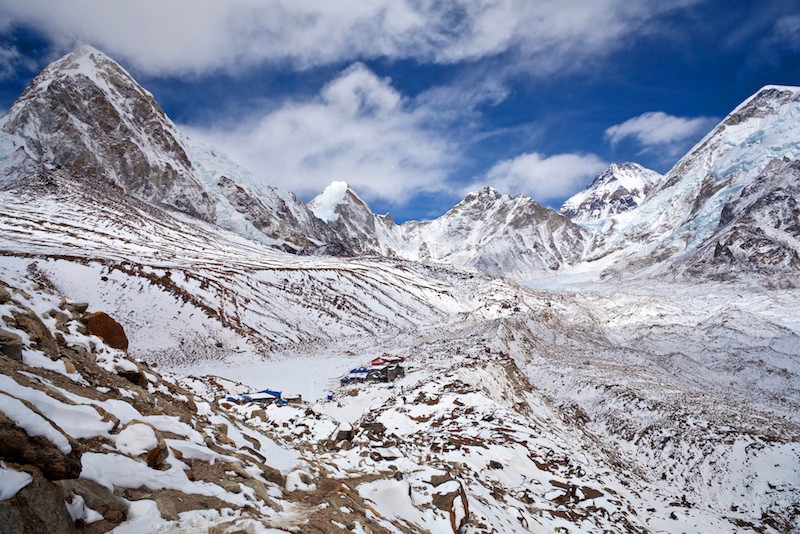Vertical shifting of glaciers has been recorded during the last fifty years. Himalayan glaciers have been losing almost half a meter of ice each year since the start of this century Scientists say mass melting could threaten water supplies for hundreds of millions of people.
 Himalayan Glaciers Melting Twice As Fast Study Environment The Jakarta Post
Himalayan Glaciers Melting Twice As Fast Study Environment The Jakarta Post
The structure of a glacier is constantly fluctuating.

Himalayan glaciers melting. Some Himalayan glaciers are more resilient to. Rock glaciers will slow Himalayan ice melt Date. Over the next 80 years according to a 2019 study of the Hindu Kush Himalaya region up to two-thirds of the Himalayan glaciers are projected to melt because of climate change.
Melting of the Himalayan glaciers caused by climate change and black carbon from pollution poses major risks to the people environment and economies in South Asia and beyond. Melting of Himalayan glaciers has doubled since the start of the 21st century due to rising temperatures losing over a vertical foot and half of ice each year and potentially threatening water. A remarkable example is Lake Imja Tsho in the Everest region while this lake was a non-existent in.
The study which appeared in Science Advances on Wednesday is the latest indication that climate change is eating the Himalayan glaciers threatening water supplies for hundreds of millions of people. Rock glaciers are similar to true ice glaciers. April 20 2021 Source.
Himalayan glaciers are melting twice as fast now as they were before the turn of the century according to a new study that relied on recently declassified Cold War-era satellite imagery. Some Himalayan glaciers are more resilient to global warming than previously predicted new research suggests. The rapid melting of Himalayan glaciers estimated to hold 600 billion tonnes of ice and which feed major perennial river systems in the region is already leading to more frequent and severe.
The melting of Himalayan glaciers has doubled since the turn of the century with more than a quarter of all ice lost over the last four decades scientists have. Himalayan glaciers melting because of high-altitude dust Dust climate change and air pollution are triple threat to water source for a billion people Sonia Aronson October 5 2020 An estimated 5 billion tons of desert dust disperses into Earths atmosphere every year. High-elevation communities are some of the most susceptible to the effects of climate change Salerno et al 2008 and a recent report concluded that even if global warming is kept below 15C a third of the glaciers in the Hindu Kush-Himalayan region and more than half of those in the eastern Himalaya will likely be lost by the end of this century Bolch et al 2019.
Himalayan glaciers melting at alarming rate spy satellites show Hotter temperatures have melted as much as a quarter of Himalayan glacial ice in. University of Exeter Summary. However with global warming occurring at an unnatural rate glaciers are melting much faster than they can be replenished.
The Himalayan glaciers are retreating at rates ranging from 10 to 60 metres per year and many small glaciers 02 sq km have already disappeared. According to report even the most ambitious goal set by the Paris Agreement to limit global warming would lead to a 21 spike in temperature in the Hindu Kush Region leading to melting of 13 rd of the regions glaciers by 2100 potentially destabilizing Asias rivers. The Himalayas are generally not melting as fast as the Alps but the general progression is similar say the researchers.
With the result of melting glaciers the lakes are growing. The study does not include. Prevention of Himalayan glacier melting.
A vital source of water for eight countries from Afghanistan to Myanmar Himalayan glaci. A newly comprehensive study shows that melting of Himalayan glaciers caused by rising temperatures has accelerated dramatically since the start of the 21st century. The analysis spanning 40 years of satellite observations across India China Nepal and Bhutan indicates that glaciers have been losing the equivalent of more than a vertical foot and half of ice each year since 2000 double the amount of melting.
Melting is natural and is counteracted by falling snow that is compacted into ice and restores the surface area of the glacier. Himalayan glaciers are melting twice as fast now as they were before the turn of the century according to a new study that relied on recently declassified Cold War-era satellite imagery.